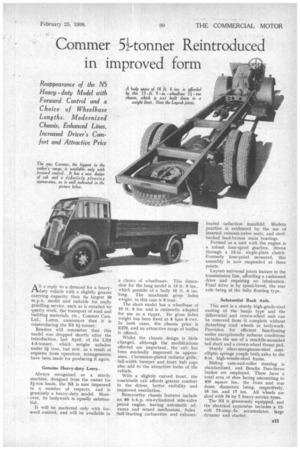Commer 5-tonner Reintroduced in improved form
Page 51

If you've noticed an error in this article please click here to report it so we can fix it.
Rcappearance of the N5 Heavy-duty Model with Forward Control and a Choice of Wheelbase Lengths. Modernized Chassis, Enhanced Lines, Increased Driver's Comfort and Attractive Price
AS a reply to a demand for a heavyduty vehicle with a slightly greater carrying capacity than its largest 30 m.p.h. model and suitable for really gruelling service, such as is entailed by quarry work, the transport of road and building materials, etc., Commer Cars, Ltd., Luton, announces that it is reintroducing the N5 54-tonner.
Readers will remember that this model was dropped shortly after the introduction, last April, of the LN5 4-5-tonner, which weighs unladen under 24 tons, but now, as a result of requests from operators, arrangements have been made for producing it again.
Genuine Heavy-duty Lorry.
Always recognized as a sturdy machine, designed from the outset for 54-ton loads, the N5 is now improved in a number of respects, and is genuinely a heavy-duty model. Moreover, its bodywork is equally substantial.
It will be marketed only with forward control, and will be available in a choice of wheelbases. This dimension for the long model is 13 ft. 9 ins., which permits of a body 16 ft. 6 ins. long. The maximum gross laden weight, in this case is 9 tons.
The short model has a wheelbase of 10 ft. 6 ins, and is eminently adapted for use as a tipper. Its gross laden weight has been fixed at 8 tons 8 cwt. In both cases, the chassis price is £370, and an attractive range of bodies is offered.
Whilst the chassis design is little changed, although the modifications effected are important, the cab has been markedly improved in appearance. Chromium-plated radiator grille, full-width bumper and front hub caps also add to-the attractive looks of the vehicle.
With a slightly curved front, the coachbuilt cab affords greater comfort to the driver, better visibility and improved ventilation.
Noteworthy chassis 'features include an 80 b.h.p. six-cylindered side-valve petrol engine, having automatic advance and retard mechanism, Solex Self-Starting carburetter and exhaust
heated induction manifold. Modern practice is evidenced by the use of inserted exhaust-valve seats, and steelbacked lead-bronze main bearings. Formed as a unit with the engine is a robust four-speed gearbox, driven through a 12-in, single-plate clutch. Formerly four-point mounted, this assembly is now suspended at three points.
Layrub universal joints feature in the transmission line, affording a cushioned drive and requiring no lubrication. Final drive is by spiral-bevel, the rear axle being of the fully floating type.
Substantial Back Axle.
This unit is a sturdy high-grade-steel casting of the banjo type and the differential and crown-wheel unit can be removed from it complete without disturbing road wheels or bodywork. Provision for efficient functioning under exceptionally arduous conditions includes the use of a straddle-mounted tail shaft and a crown-wheel thrust pad. Sturdy silico-manganese-steel semielliptic springs couple both axles to the 8-in, high-tensile-steel frame.
Bishop cam-and-roller steering is standardized, and Bendix Duo-Servo brakes are employed. These have a total area of shoe facing amounting to 400 square ins., the front and rear drum diameters being, respectively, 16 ins. and 17 ins. All wheels are shod with 34 by 7 heavy-service tyres. The N5 is generously equipped, and the electrical apparatus includes a 12volt 72-amp.-hr. accumulator, large dynamo and starter.
































































































